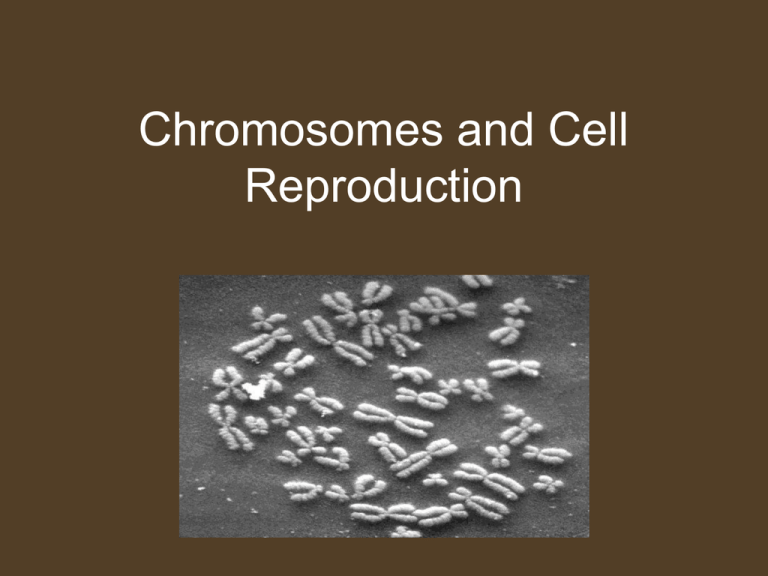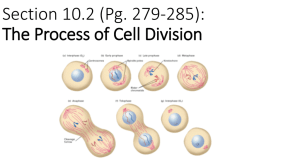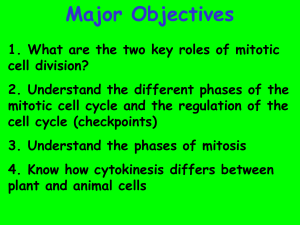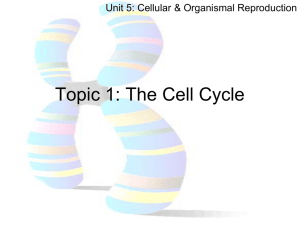
Chromosomes and Cell
Reproduction
Cell Growth
– Most living cells are between 2 and 20 µm in
diameter.
– How big a cell can grow is determined by physical
factors below:
1. Diffusion rate of materials into and out of
the cell. (Remember diffusion only works will
over short distance
2. The amount of DNA available to program
the cell’s metabolism.
3. The cell’s surface area-to-volume ratio.
– So, mitosis is important for cell survival by taking a
large cell and dividing it into two identical smaller cells
with identical diploid (2n) genetic material.
Cell Division
– Cell division, also called cell reproduction occurs in humans.
1. Eukaryotic organisms undergoing growth, development, and
repair divide their cells by mitosis.
2. Bacteria cells undergoing reproduction divide by binary
fission.
– Binary fission is a form of asexual reproduction that produces
identical offspring.
– In asexual reproduction, a single parent passes exact copies of
all its DNA to its offspring (clones).
3. The formation of gametes involves a third type of cell division.
– Gametes, an organism’s reproductive cells, such as sperm or
egg cells.
– Regardless of the type of cell division that occurs, all of the
DNA (deoxyribonucleic acid) must be present in each of the
resulting cells.
Chromosomes: The cell structure in the nucleus that carries the
genetic material—DNA.
–
Chromosomes are the structures that carry MOST genetic
information.
A. Chromosome Structure: A chromosome is a very long DNA
molecule that contains many genes.
Chromatin- It is the DNA and proteins in the nucleus of a nondividing cell.
During most of a cell’s life cycle (interphase)
chromosomes exist as chromatin, which are strands of
DNA wrapped around protein molecules (uncoiled like
tangled-up spaghetti). Chromatin is not visible during
this stage. DNA can not be seen under a compound
light microscope. DNA can be seen under an electron
microscope.
Chromatin
Chromosome
State Test Question
•
What structures carry the MOST genetic
information for a leaf cell?
a)
b)
c)
d)
Chromosomes
Ribosomes
Centrioles
Chloroplasts
State Test Question
• Which of the structures labeled below contains chromosomes?
–
–
–
–
a
b
c
d
Chromosome Structure Cont.
Two Parts of the Chromosome:
1. Chromatid- Before the DNA coils up, DNA is
copied
The chromatin coils up into two
identical parts of a chromosome, which
are called chromatids. AKA—sister
chromatids.
2. Centromere-The point at which
each pair of chromatids are attached.
Holds chromatid
(duplicated chromosomes) together.
A chromatid is
attached to a spindle
fiber by the centromere.
State Test Question
a) Chromatin
b) Centromere
c) Centriole
d) Centrosome
Chromosome Numbers:
1. All sexually reproducing organisms have pairs of
chromosomes.
** Organisms range in number of chromosomes from 2
to over 300. Ferns have 1,262 Chromosomes.
2. Homologous Chromosomes: are pairs (2) of
chromosomes that are similar in size, shape, and
genetic content
-Each homologous chromosome comes from one of
the two parents.
-Example: The 46 chromosomes in human
somatic cells (body cells) are actually 2 sets
of 23 chromosomes—1 set from the mother
-1 set from the father.
-Example: If one chromosome in a pair
contains a gene for eye color, so will the
other chromosome in that pair.
Chromosome Numbers:
3. Diploid (2n):
When a cell, such a somatic cell,
contains sets of chromosomes, it is said to be diploid.
The diploid number in a somatic cell can be written as
2n=46.
**Biologists us the symbol 2n to represent 2 sets of
chromosomes.
How many homologous pairs of chromosomes do
humans have?__23___
4. Haploid (n): When a cell, such as a sex cell (gamete),
contains one set of chromosomes, it is said to be
haploid.
n= 1 set of chromosomes
The haploid number in a gamete=23
n = 23 (half of 46)
Fertilization is the joining of gametes (sex cells_ from
opposite sexes.
A zygote is a fertilized egg cell, the first cell of a new
individual.
Fertilization
Zygote
Chromosomes Determine Your Sex:
• Of the 23 pairs of chromosomes in human somatic cells,
22 pairs are called autosomes.
• Autosomes are chromosomes that are not directly
involved in determining the sex (gender) of an individual.
• The sex chromosomes, one of the 23 pairs of
chromosomes in humans, contain genes that determine
the sex of an individual.
• In humans, the two sex chromosomes are X and Y
chromosomes.
• XY chromosomes = male
• XX chromosomes = female
• Because a female can donate
only an X chromosome to her
offspring, the sex of an offspring
is determined by the male, who
can donate either an X or a Y.
Change in Chromosome Structure
•
A change in an organism’s
structure is called a mutation.
• Breakage of a chromosome can lead to four
types of mutations.
Four Types of Mutations:
1. Deletion mutation- a piece of chromosome
breaks off completely.
After cell division, the new cell will lack a
certain set of genes. Often this is fatal to the
zygote.
2. Duplication mutation- a chromosome
fragment attaches to its homologous
chromosome, which then carry two copies of
a certain set of genes.
Duplication Mutation
Deletion Mutation
3.Inverse mutation- the chromosome piece
reattaches to the original chromosome but in
a reverse position.
4.If the piece of chromosome that broke off
reattaches to a non-homologous
chromosome, a translocation mutation
Inverse Mutation
results.
Translocation Mutation
The Cell Cycle
–
–
–
–
–
–
The life of a eukaryotic cell is the cell cycle which includes
interphase, mitosis, and cytokinesis.
A cell can only grow so large, when it reaches a certain point it
will divide into two cells.
So, the cell is as large as it can get—then it divides and the two
cells are small. This process is called mitosis.
The cell cycle is a repeating sequence of cellular growth and
division during the life of an organism.
A cell spends 90% of its time in the first three phases of the
cycle.
What phase does the cell spend the most time? Interphase
State Test Question
a)
b)
c)
d)
When using a light microscope,
which of the following structures is
first visible when a cell is dividing?
Mitochondrion
Ribosome
Chromosome
Lysosome
State Test Question
The ongoing process in which cells
grow, develop, and reproduce is
called—
a) meiosis.
b) mitosis.
c) the cell cycle.
d) interkinesis.
Interphase:
• The busiest and longest part of the cell cycle.
• The cell is growing and the chromosomes are
replicating (copying).
• Before mitosis begins, the chromosomes are copied.
• Each chromosome now consists of two chromatids.
• *Humans have 46 chromosomes (23 pairs), so now 92
chromosomes are ready for cell division.
–
•
46 will end up in 1 cell, and the other 46 will end up in the 2nd
cell.
DNA is the form of chromatin.
–
Since DNA is the form of chromatin, it is not visible
Interphase has THREE distinct phases:
1. G1 phase— Cellular growth.
2. S phase— Cellular growth and DNA synthesis—
DNA (chromatin) is replicated.
3. G2 phase— Cellular growth and preparation for
cell division mitosis.
State Test Question
G1 Phase, S Phase, and G2 Phase are all
parts of—
a) Interphase.
b) Anaphase.
c) Prophase.
d) Teophase.
Mitosis
• Mitosis is the division of all somatic (body cells/non-sex cells). A
cut on your hand will repair itself using the process of mitosis.
• The first step of mitosis is the chromatin coiling up into
chromosomes.
• The first three steps are all involved with the splitting of the
nucleus.
• The last step involves the splitting of the cytoplasm, known as
cytokinesis.
• The end result of mitosis is the formation of two identical
daughter cells that are diploid (have a full set of chromosomes
[2n]).
• Mitotic cell division: The parent cell divides to form 2 daughter
cells with the same number of chromosomes 2n=46.
–
•
For example: A human cell has 46 chromosomes. How many
chromosomes will it have after mitotic cell division?
__46_______
Here are the four stages of Mitosis:
1. Prophase 2. Metaphase 3. Anaphase 4. Telophase
State Test Question
A frog cell has 26 chromosomes. After the
first mitotic division, the cells produced
by the zygote will have—
a) 52 chromosomes.
b) 39 chromosomes.
c) 26 chromosomes.
d) 13 chromosomes
Prophase (P)
a. Stringy chromatin coils up into chromosomes.
Chromosomes are most easily seen during this phase because
the chromatin shortens and thickens.
Each duplicated chromosome is made of the two halves called
sister chromatids.
Sister chromatids and the DNA they contain are exact copies of
each other and are formed when DNA is copied during
interphase.
b. Nuclear membrane disintegrates (disappears)
Spindle forms between the pair of centrioles which begin to
move to the opposite end (poles).
Spindles are cell structures made up of
both centrioles and individual microtubule
fibers that are involved in moving
chromosomes during cell division. Centrioles help anchor spindles for movement
of chromosomes. The spindles pull the
chromosomes to opposite sides of the cell.
State Test Question
Chromosomes are most easily seen during
cell division because the chromosomes-a) double in number.
b) shorten and thicken.
c) move and expand.
d) match up with other chromosomes
State Test Question
Which of the following does NOT occur
during interphase?
a) Chromosomes become visible
b) Proteins synthesize
c) Chromosomes duplicate
d) Proteins translocate
The Cell Cycle
Metaphase (M)
• Chromosomes line up along the equator.
(Centromeres are attached to the spindle fibers.)
State Test Question
Which phase of mitosis is represented by
the diagram shown above?
a) Metaphase
b) Prophase
c) Telophase
d) Interphase
The Cell Cycle
Anaphase (A)
a. Centromeres split separating chromatids.
Chromatids are now called chromosomes.
b. Chromosomes move toward opposite poles.
The Cell Cycle
Telephase (T)
a) The identical chromatids, now chromosomes, reach
opposite poles.
b) Nuclear membrane reappears
c) Spindles disappear
d) Chromosomes uncoil into threadlike pieces
DNA is now called chromatin
As mitosis ends, cytokinesis begins.
Cytokinesis:
Divides the cytoplasm and organelles
between the two new cells.
**New daughter cells
will enter into
Interphase to begin
the cycle over again.
State Test Question
•
a)
b)
c)
d)
Which phase of the cell cycle involves
replication of chromosomes?
G1 of interphase
The synthesis phase of interphase
Prophase
Cytokinesis
State Test Question
•
a)
b)
c)
d)
Following telophase, two daughter cells
are created when new membranes are
formed in the process called—
interkinesis.
cytokinesis.
chromosome replication.
crossing over.
State Test Question
Lab Notes▪ Chromatids have been separated ▪
The cytoplasm is separating▪ A visible line is
forming between sets of chromatids
Which phase of mitosis is being described in the
lab notes shown above?
a) Telophase
b) Anaphase
c) Metaphase
d) Prophase
State Test Question
The stages of cell division called prophase,
metaphase, anaphase, and telophase
occur during which stage of the cell cycle
shown in the diagram below?
a) G1
b) S
c) M
d) C
State Test Question
Which event in mitosis has NOT yet
occurred?
a)
b)
c)
d)
Chromosomes lining up
Spindle fibers shortening
Chromosomes duplicating
Cytoplasm dividing
What are the differences in animal cells and in plant
cells undergoing mitosis?
1. Plant cells do NOT have centrioles
2. Plant cells divide their cytoplasm with a cell
plate.
3. In animal cells, cytokinesis begins with a cleavage
furrow, which pinches the cell into 2 cells.
Centrioles
The Cell Cycle
Factors that control the cell cycle:
•
The cell cycle is carefully controlled. Failure of cellular control can
result in cancer.
•
Cancer is the uncontrolled growth of cells. Cancer is a disorder of
cell division.
•
Cancer is a mistake in the cell cycle.
•
Cancer is one result of uncontrolled cell division.
•
The loss of control may be caused by environmental factors or by
changes in enzyme production.
•
Cancerous cells affect normal cells, forming
masses of tissue called tumors that deprive
normal cells of nutrients. In the final stages,
cancer cells enter the circulatory system and
spread throughout the body forming new tumors
that disrupt the functioning of organs.
Lung Cancer Cells
State Test Question
Which of the following BEST describes the
purpose of mitosis?
a) The production of a complete copy of the
nucleus before cell division
b) The division of the cell after the nucleus
has been copied
c) The production of gametes with half the
number of chromosomes of a normal cell
d) The replication of DNA within the nucleus
State Test Question
Which of the following process is
MOST responsible for getting
genetic information to each cell in
the body of an organism?
a) Protein synthesis
b) Mitosis
c) Diffusion
d) Respiration










